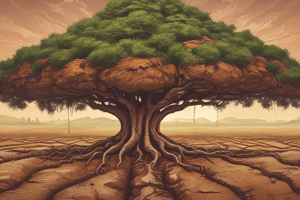Podcast
Questions and Answers
Why is soil considered an interface in the Earth system?
Why is soil considered an interface in the Earth system?
It's a common boundary where different parts of a system interact. Soil forms where the solid earth, atmosphere, hydrosphere, and biosphere meet.
What are the four components of soil?
What are the four components of soil?
45% mineral matter; 25% air; 25% water; 5% organic matter.
How is regolith different from soil?
How is regolith different from soil?
Regolith is the layer of rock and mineral fragments produced by weathering, while soil is part of the regolith that supports plant growth.
What's the difference between sand and clay with regard to texture/grain size?
What's the difference between sand and clay with regard to texture/grain size?
Why is texture an important soil property?
Why is texture an important soil property?
What is loam?
What is loam?
What is 'soil structure'?
What is 'soil structure'?
List the four soil structures and the infiltration of each.
List the four soil structures and the infiltration of each.
The five basic controls of soil formation are: __________.
The five basic controls of soil formation are: __________.
How do soil-forming processes operate?
How do soil-forming processes operate?
Describe the horizons (zones or layers of soil) in temperate regions.
Describe the horizons (zones or layers of soil) in temperate regions.
What horizons does the topsoil consist of?
What horizons does the topsoil consist of?
What horizons does the solum layer consist of?
What horizons does the solum layer consist of?
What is another name for the solum layer?
What is another name for the solum layer?
What horizon does the subsoil consist of?
What horizon does the subsoil consist of?
Name and define 4 features or processes of soil formation.
Name and define 4 features or processes of soil formation.
Why are soils classified?
Why are soils classified?
How many soils are named in the Soil Taxonomy system?
How many soils are named in the Soil Taxonomy system?
How many hierarchical categories are there in the Soil Taxonomy system?
How many hierarchical categories are there in the Soil Taxonomy system?
What language origin are the names in the Soil Taxonomy system derived from?
What language origin are the names in the Soil Taxonomy system derived from?
What is the Soil Taxonomy system useful for?
What is the Soil Taxonomy system useful for?
What is soil erosion?
What is soil erosion?
What are the 4 factors affecting the natural rate of soil erosion?
What are the 4 factors affecting the natural rate of soil erosion?
What is the Global Soil Regions?
What is the Global Soil Regions?
How have human activities affected the rate of soil erosion?
How have human activities affected the rate of soil erosion?
What are two detrimental effects of soil erosion aside from the loss of topsoil?
What are two detrimental effects of soil erosion aside from the loss of topsoil?
Do we see the formation of some ore as the result of weathering?
Do we see the formation of some ore as the result of weathering?
Define horizon.
Define horizon.
What is soil texture?
What is soil texture?
What is a soil profile?
What is a soil profile?
What is the difference between erosion and weathering?
What is the difference between erosion and weathering?
Other than water, what is a necessary factor for soils to form?
Other than water, what is a necessary factor for soils to form?
What effects have man's activity had on soil erosion?
What effects have man's activity had on soil erosion?
Flashcards
Soil Interface
Soil Interface
The boundary where the solid Earth, atmosphere, hydrosphere, and biosphere interact.
Regolith
Regolith
The weathered layer of rock fragments covering Earth's surface.
Soil
Soil
The layer of regolith that specifically supports plant growth.
Soil Texture
Soil Texture
Signup and view all the flashcards
Soil Structure
Soil Structure
Signup and view all the flashcards
Eluviation
Eluviation
Signup and view all the flashcards
Illuviation
Illuviation
Signup and view all the flashcards
Hardpan
Hardpan
Signup and view all the flashcards
Weathering
Weathering
Signup and view all the flashcards
Erosion
Erosion
Signup and view all the flashcards
Soil Profile
Soil Profile
Signup and view all the flashcards
Secondary Enrichment
Secondary Enrichment
Signup and view all the flashcards
Horizon
Horizon
Signup and view all the flashcards
Loam
Loam
Signup and view all the flashcards
Soil Formation
Soil Formation
Signup and view all the flashcards
Topsoil
Topsoil
Signup and view all the flashcards
Solum
Solum
Signup and view all the flashcards
Subsoil
Subsoil
Signup and view all the flashcards
Soil Taxonomy
Soil Taxonomy
Signup and view all the flashcards
Soil Erosion
Soil Erosion
Signup and view all the flashcards
Soil Conservation Practices
Soil Conservation Practices
Signup and view all the flashcards
Sedimentation
Sedimentation
Signup and view all the flashcards
Global Soil Regions
Global Soil Regions
Signup and view all the flashcards
Human Impacts on Soil Erosion
Human Impacts on Soil Erosion
Signup and view all the flashcards
Factors Influencing Soil Erosion Rate
Factors Influencing Soil Erosion Rate
Signup and view all the flashcards
Poorly Developed Soils
Poorly Developed Soils
Signup and view all the flashcards
Study Notes
Soil as an Interface
- Soil represents a boundary where the solid earth, atmosphere, hydrosphere, and biosphere interact.
Components of Soil
- Consists of 45% mineral matter, 25% air, 25% water, and 5% organic matter.
Regolith vs. Soil
- Regolith is the layer of weathered rock and mineral fragments covering Earth's surface; soil specifically supports plant growth.
Texture and Grain Size
- Sand has larger, coarser grains, while clay comprises smaller, finer particles.
Importance of Soil Texture
- Texture significantly affects soil's ability to retain and transmit water and air, which are crucial for plant growth.
Loam Definition
- Loam is a balanced mixture of sand, silt, and clay, ideal for nutrient retention and moisture.
Soil Structure
- Describes the arrangement of soil particles; platy and spheroidal structures slow nutrient movement; prismatic and blocky structures allow moderate water infiltration.
Controls of Soil Formation
- Factors include climate, organisms, parent material, topography, and time.
Soil-Forming Processes
- Operate primarily from the surface downwards, impacting layer development over time.
Soil Horizons in Temperate Regions
- Temperate regions feature five horizons: O (organic), A (topsoil), E (eluviation), B (illuviation), and C (parent material).
Composition of Soil Layers
- Topsoil consist of O and A horizons; the solum includes O, A, E, and B horizons, also called true soil, while the subsoil is primarily the B horizon.
Soil Formation Features
- Eluviation is the leaching out of materials; zone of accumulation refers to deposits in the B horizon; hardpan forms from compacted clay layers.
Purpose of Soil Classification
- Soil Taxonomy categorizes soils based on their physical and chemical properties for understanding and analysis in contexts like agriculture.
Soil Taxonomy System
- Features 12 named soils organized into six hierarchical categories; names derived from Latin and Greek; useful for agriculture, not engineering evaluations.
Soil Erosion
- A natural process where water and wind transport soil components, resulting in potential displacement of topsoil.
Factors Influencing Soil Erosion Rate
- Influenced by soil characteristics, climate, slope angle, and type of vegetation.
Global Soil Regions
- Reference to worldwide distribution of 12 soil orders, shaped by climatic influences, with poorly developed soils at higher latitudes.
Human Impact on Soil Erosion
- Practices like windbreaks, terracing, contour plowing, and crop rotation are used to mitigate erosion effects.
Detrimental Effects of Soil Erosion
- Sedimentation can lead to reservoir capacity loss and costly dredging; chemical pollution affects water quality.
Ore Formation through Weathering
- Secondary enrichment occurs via chemical weathering, where desirable minerals are concentrated in lower zones; examples include bauxite for aluminum.
Horizon Definition
- A specific layer within a soil profile.
Soil Texture Explanation
- Defined by the proportion of clay, silt, and sand, significantly impacting water retention and air transmission.
Soil Profile Description
- A vertical cross-section displaying different soil horizons and the parent material.
Erosion vs. Weathering
- Erosion involves material transport by agents like water or wind, while weathering is the breakdown and decomposition of rocks.
Factors Necessary for Soil Formation
- Requires parent material, time, climate, and organic contributions from plants and animals; topography affects soil development.
Human Activity and Soil Erosion
- Common activities like farming and logging accelerate erosion, leading to sedimentation in waterways and contamination of water supplies.
Studying That Suits You
Use AI to generate personalized quizzes and flashcards to suit your learning preferences.



